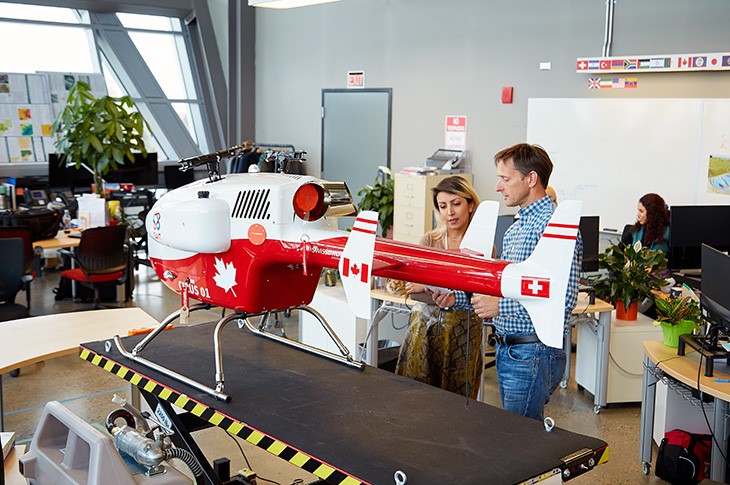SAIT ranked one of Canada's top five research colleges for 2024

Two robot arms are ready to work in one of the Centre for Innovation and Research in Advanced Manufacturing and Materials lab within ARIS.
SAIT broke the top five — climbing to fourth place from last year’s sixth place on Research Infosource Inc.’s Top 50 Research Colleges 2024, released on Thursday, Dec. 5. This list is part of the annual Canada’s Innovation Leaders (CIL) report, which highlights top research universities, corporations, hospitals and colleges that are boosting Canada’s global competitiveness in the knowledge economy.
SAIT’s Applied Research and Innovation Services is 79,000 square feet of state-of-the-art research labs and facilities fuelled by a dynamic team of more than 70 research experts dedicated to developing practical solutions to real-world problems.
“SAIT has made significant strides in research and innovation this year, and to see the culmination of those efforts reflected in a fourth-place ranking among the top research colleges in Canada is a fitting accomplishment,” says Dr. David Ross, President and CEO, SAIT. “Through industry-driven research and a forward-thinking approach to innovation, SAIT’s ARIS continues to set new standards for developing practical solutions to real-world problems.” As part of this year’s ranking, SAIT excelled in the Industry Research Income category, securing the top position with $9.5 million from industry sources.
“The ARIS Hub is a point of connection within the applied research ecosystem in Canada," says Jamie McInnis, Director, ARIS Hub. "In our state-of-the-art facilities, we’re bringing experts and industry partners together to develop innovative solutions that matter.”
Key research areas include:
- Centre for Energy Research and Clean Unconventional Technology Solutions (CERCUTS)
- Centre for Innovation and Research in Advanced Manufacturing and Materials (CIRAMM)
- Centre for Innovation and Research in Unmanned Systems (CIRUS)
- Green Building Technology Access Centre (GBTAC)
Each year, ARIS works with more than 200 companies on engagements, assessments, and research projects, leading to the development of approximately 100 prototypes. In 2024, SAIT received $17.5 million dollars in research funding (in-kind or cash) through ARIS.
Researching sustainable building technologies at GBTAC

Headquartered in the “house” at the northwest corner of SAIT’s main campus, the Green Building Technology Access Centre (GBTAC) plays a pivotal role in addressing the crisis in Canada's building design and construction industry. Since 2008, GBTAC has supported industry sectors as they grappled with labour shortages, affordability concerns, climate change pressures and evolving regulations, while increasing service to underrepresented groups.
Now, going into its third five-year term as one of Canada’s Technology Access Centres (TAC), GBTAC has been awarded $1.75 million in funding from NSERC over five years. As recognized leaders in college applied research organizations, TACs assist Canadian entrepreneurs in developing new innovative products and solutions using technology.
GBTAC is the only TAC in Canada delivering holistic green building training, research and innovation services to Alberta and surrounding regions. Its research emphasizes housing affordability and greenhouse gas emission reduction. Projects focus on three key areas: building science and durability, building monitoring and energy systems integration, and architectural environment. Over the past five years, GBTAC has collaborated with nearly 300 partners — including industry, municipalities, not-for-profits, and Indigenous communities — and delivered over 500 services to advance technology, policies and educational programs.
Partnership with NATO Defence innovation accelerator for the North Atlantic
NATO’s Defence Innovation Accelerator for the North Atlantic (DIANA) network is working to connect innovators with the resources needed to develop dual-use technologies with a wide variety of security and civilian applications.
The ARIS Hub is joining the network to lend its expertise in materials science, advanced manufacturing, Artificial intelligence, robotics and automation through CIRAMM. As one of two test centres in Alberta and 13 in Canada, CIRAMM will provide services to support start-ups and entrepreneurs as they demonstrate and validate emerging security solutions. Access to SAIT’s cutting-edge facilities and advice from our team of research experts will be available to innovators associated with DIANA’s more than 200 affiliated sites and centres.
Improving medical service for remote areas with drones

Using a Remotely Piloted Aircraft System (RPAS) capable of lifting up to 45kg, this joint research project with CIRUS and partners at the University of Calgary, Alberta Health Services, Stoney Nakoda Nation and Frog Lake First Nation, works to improve medical services for Indigenous communities and remote access sites.
Born out of the COVID-19 pandemic, the project has evolved from using RPAS to test the delivery of PPE and test kits to remote communities, as well as their safe return to medical centres for testing. The next phase involved the delivery of Stop the Bleed kits to injured patients and now the team is researching the delivery of Start the Breath kits to people experiencing respiratory distress.
All these stages have one goal — to extend the time for the patient to reach medical facilities. The drone delivers the kit within reachable distance of the patient or companion, who then unpacks the kit, sets up a phone to connect with a remote medical mentor and together they treat the injury.
The combination of RPAS medical delivery using beyond visual line-of-sight operation and remote communication support could improve outcomes for those living in Indigenous communities and remote access sites.
Industry driven — industry driver
SAIT's Applied Research and Innovation Services (ARIS) team develops new or improved technologies in response to the innovation needs of industry.
Partner with ARISIndustry Driven
We prepare students for successful careers and lives.
SAIT'S
2020-2025
Strategic plan

Oki, Âba wathtech, Danit'ada, Tawnshi, Hello.
SAIT is located on the traditional territories of the Niitsitapi (Blackfoot) and the people of Treaty 7 which includes the Siksika, the Piikani, the Kainai, the Tsuut’ina and the Îyârhe Nakoda of Bearspaw, Chiniki and Goodstoney.
We are situated in an area the Blackfoot tribes traditionally called Moh’kinsstis, where the Bow River meets the Elbow River. We now call it the city of Calgary, which is also home to the Métis Nation of Alberta.